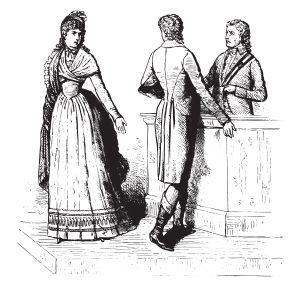How Has Divorce Changed Over the Years?
Posted on April 30, 2020 in Divorce
 Much of the data today suggests that around 40% of all marriages end in divorce, as opposed to the popular belief over the last several decades that divorce is the end result of at least half of all marriages. Even though it may seem like a recent trend, the concept of divorce has actually been around in history for much longer than the last century, and it has always been at the forefront of many spouses’ minds. Here are some interesting facts about divorce and its evolution throughout history:
Much of the data today suggests that around 40% of all marriages end in divorce, as opposed to the popular belief over the last several decades that divorce is the end result of at least half of all marriages. Even though it may seem like a recent trend, the concept of divorce has actually been around in history for much longer than the last century, and it has always been at the forefront of many spouses’ minds. Here are some interesting facts about divorce and its evolution throughout history:
A Brief History of Divorce
Believe it or not, the idea of divorce may have been around for as long as the institution of marriage itself. For instance, King Henry VIII asked the Pope to let him divorce Catherine of Aragon. After the Pope refused, Henry VIII divorced her anyway, remarrying Anne Boleyn instead, and this would prove to be the catalyst for the Church of England separating from the Roman Catholic Church. Overall, people’s perceptions of divorce and the laws surrounding the dissolution of marriage have changed and evolved over the years in a variety of ways, including:
-
Divorce saw one of its earliest spikes in North America during the American Revolution. The same ideology of personal liberty that contributed to the country’s founding did not just color people’s visions of government; it also affected how they viewed marital vows.
-
Early divorce laws in the 1800s strictly required physical proof of cruelty or adultery. However, lawyers and spouses alike became creative with their interpretation of the laws, which led to the creation of “omnibus clauses” to enable divorces based on the court’s own best judgment.
-
Even with divorce laws in the late 1800s and early 1900s requiring “fault-based” filings, the divorce rates continued to rise. The stipulations with regards to these “fault-based divorces” led to a wide array of issues, such as:
-
The “Clean Hands Doctrine,” which meant that the person filing the divorce could not have contributed in any way to the dysfunction and dissolution of the marriage. In other words, two people who hated being married to each other could not get a divorce under this doctrine.
-
In Illinois, “fault-based” was taken to a new extreme when judges began allowing testimony from witnesses saying that they saw physical marks on someone’s skin from slaps or other physical abuse, which could not really be proven and would probably be declared hearsay in a modern courtroom.
-
In the late 1960s, then-Governor Ronald Reagan introduced the Family Law Act in California, which enabled “irreconcilable differences” as a reason for divorce, paving the way for the now-common “no fault” divorce laws that are used in most states, including in Illinois. Fortunately, this advent in divorce law has made the divorce process much less adversarial and, in many cases, fairer and much more collaborative.
Contact a Wheaton Divorce Lawyer
Now that you know how far the divorce laws have come, you can see how fortunate you are to live in this day and age. Something as beneficial as collaborative law and mediation for your divorce would probably not have been possible during times when spouses were exceedingly combative with each other and required creative interpretations of divorce laws. For legal help to ensure that your rights are protected during the end of your marriage, call a DuPage County family law attorney at 630-871-1002 to arrange a free consultation today.
Sources:
https://time.com/4521314/divorce-history-sarah-jessica-parker/
https://www.theatlantic.com/magazine/archive/2020/03/the-nuclear-family-was-a-mistake/605536/
https://www.psycom.net/divorce-culture









